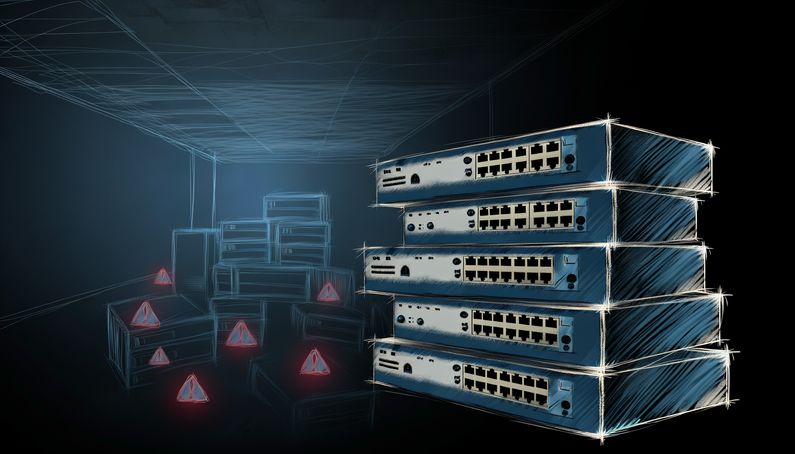
Exploitation of End-of-Life Routers: A Growing Cybersecurity Threat
End-of-life routers, often neglected and left without security updates, have become a playground for cybercriminals. These outdated devices are exploited to create proxy networks, allowing malicious actors to mask their activities. The FBI has highlighted the growing threat posed by these compromised routers, which are frequently targeted due to their vulnerabilities (IC3). TheMoon malware, a notorious threat, exploits these routers to establish proxy services, facilitating anonymous internet traffic and enabling cybercriminals to conduct illicit activities without revealing their true locations (Trend Micro). This situation underscores a critical cybersecurity challenge, as these compromised devices are often used in larger botnets for various malicious purposes, including DDoS attacks and espionage (Malwarebytes).
Exploitation of End-of-Life Routers
End-of-life routers, which no longer receive manufacturer support or security updates, are increasingly being targeted by cybercriminals. These devices, often left vulnerable due to outdated firmware, serve as prime targets for exploitation. Cyber actors utilize these routers to install malware, such as variants of TheMoon, which allows them to establish proxy networks. These networks enable criminals to conduct illicit activities while masking their true locations. The lack of updates and security patches makes these routers susceptible to known vulnerabilities, making them a critical concern for cybersecurity (IC3).
TheMoon Malware and Proxy Networks
TheMoon malware has been identified as a significant threat to end-of-life routers. This malware variant compromises routers with remote administration enabled, allowing cyber actors to install proxy services. These proxies facilitate anonymous internet traffic, obscuring the cybercriminals’ identities and locations. By using these compromised routers, criminals can engage in activities such as cryptocurrency theft and illegal transactions without revealing their real IP addresses (IC3).
The Functionality of TheMoon Malware
TheMoon malware operates by exploiting vulnerabilities in outdated routers. Once installed, it transforms the router into a proxy server, which acts as an intermediary between the user and the internet. This setup enables cybercriminals to reroute their traffic through the compromised device, effectively hiding their digital footprint. The malware’s ability to install proxies on unsuspecting routers makes it a potent tool for cybercriminals seeking anonymity (Trend Micro).
Impact on Cybersecurity
The exploitation of end-of-life routers poses a significant threat to cybersecurity. These compromised devices are often used as part of larger botnets, which can be employed for various malicious purposes. Botnets consisting of compromised routers can be used for distributed denial-of-service (DDoS) attacks, espionage, and other cybercrimes. The anonymity provided by proxy networks makes it challenging for law enforcement agencies to trace the origin of these attacks (Malwarebytes).
Botnets and Cyber Espionage
Cybercriminals and nation-states alike exploit compromised routers to create botnets. These networks of infected devices can be used for espionage operations, blending espionage traffic with other cybercrime-related activities. For instance, the Sandworm group has utilized botnets consisting of hacked routers for their operations. The disruption of such botnets by agencies like the FBI highlights the ongoing battle against cyber threats (Trend Micro).
FBI’s Response and Mitigation Efforts
In response to the growing threat posed by compromised routers, the FBI has taken proactive measures to mitigate the risks. The agency has conducted court-authorized operations to take control of infected routers, removing malware and restoring the devices to their original state. These efforts aim to prevent further exploitation by cybercriminals and protect critical infrastructure from potential attacks (Malwarebytes).
Legal and Technical Interventions
The FBI’s approach involves both legal and technical interventions. By obtaining court orders, the agency gains the authority to access and clean compromised routers. This process includes extensive testing to ensure that malware removal does not impact the legitimate functions of the devices. The FBI also works to inform router owners or their providers about the vulnerabilities, encouraging them to replace end-of-life routers with more secure alternatives (Department of Justice).
Recommendations for Router Owners
To mitigate the risks associated with end-of-life routers, the FBI strongly advises owners to replace outdated devices with newer models that receive regular security updates. Additionally, router owners should disable remote administration features unless absolutely necessary. Regularly updating firmware and employing strong, unique passwords can further enhance the security of these devices. By taking these precautions, individuals and businesses can reduce their vulnerability to cyber threats (Cleveland.com).
Best Practices for Securing Routers
Implementing best practices for router security is crucial in preventing exploitation. Users should regularly check for firmware updates and apply them promptly. Disabling unnecessary features, such as remote administration, can minimize exposure to potential attacks. Additionally, using strong encryption protocols for wireless networks and regularly changing passwords can help safeguard against unauthorized access. Educating users about the importance of router security is essential in fostering a more secure digital environment (Canadian Centre for Cyber Security).
Future Outlook and Challenges
As technology continues to evolve, so do the tactics employed by cybercriminals. The increasing sophistication of cyber threats necessitates ongoing vigilance and adaptation. The cybersecurity landscape is expected to face new challenges, including AI-driven attacks and post-quantum threats. Organizations must remain proactive in addressing these emerging risks, investing in advanced security measures and staying informed about the latest threat trends (Security Info Watch).
Anticipated Trends in Cybersecurity
The future of cybersecurity is likely to be shaped by several key trends. The rise of AI-driven attacks presents new challenges, as cybercriminals leverage machine learning to automate and enhance their operations. Additionally, the transition to post-quantum cryptography will require organizations to reassess their security protocols. As cyber threats become more sophisticated, collaboration between governments, private sectors, and cybersecurity experts will be crucial in developing effective defense strategies (Fortinet).
By understanding the current threat landscape and implementing robust security measures, individuals and organizations can better protect themselves against the exploitation of end-of-life routers and other cyber threats.
Final Thoughts
The exploitation of end-of-life routers represents a significant cybersecurity threat that requires immediate attention. The FBI’s proactive measures, including court-authorized operations to clean infected routers, highlight the importance of both legal and technical interventions in combating these threats (Malwarebytes). As technology evolves, so do the tactics of cybercriminals, necessitating ongoing vigilance and adaptation. The rise of AI-driven attacks and the transition to post-quantum cryptography are anticipated trends that will shape the future of cybersecurity (Fortinet). By understanding these challenges and implementing robust security measures, individuals and organizations can better protect themselves against the exploitation of outdated routers and other cyber threats.
References
- Internet Crime Complaint Center (IC3). (2025). Public Service Announcement. https://www.ic3.gov/PSA/2025/PSA250507
- Trend Micro. (2024). Router Roulette: The Risks of End-of-Life Routers. https://www.trendmicro.com/en_gb/research/24/e/router-roulette.html
- Malwarebytes. (2024). FBI Removes Malware from Hundreds of Routers Across the US. https://www.malwarebytes.com/blog/news/2024/02/fbi-removes-malware-from-hundreds-of-routers-across-the-us
- Department of Justice. (2025). US Government Disrupts Botnet Used by People’s Republic of China. https://www.justice.gov/opa/pr/us-government-disrupts-botnet-peoples-republic-china-used-conceal-hacking-critical
- Cleveland.com. (2025). FBI Warns of Alarming New Cyber Threat Targeting Homes, Businesses. https://www.cleveland.com/nation/2025/05/fbi-warns-of-alarming-new-cyber-threat-targeting-homes-businesses.html
- Canadian Centre for Cyber Security. (2025). National Cyber Threat Assessment 2025-2026. https://www.cyber.gc.ca/en/guidance/national-cyber-threat-assessment-2025-2026
- Security Info Watch. (2025). Cybersecurity 2025: Preparing for an Evolving Threat Landscape. https://www.securityinfowatch.com/cybersecurity/article/55253140/cybersecurity-2025-preparing-for-an-evolving-threat-landscape
- Fortinet. (2025). Threat Landscape Report. https://www.fortinet.com/resources/reports/threat-landscape-report



